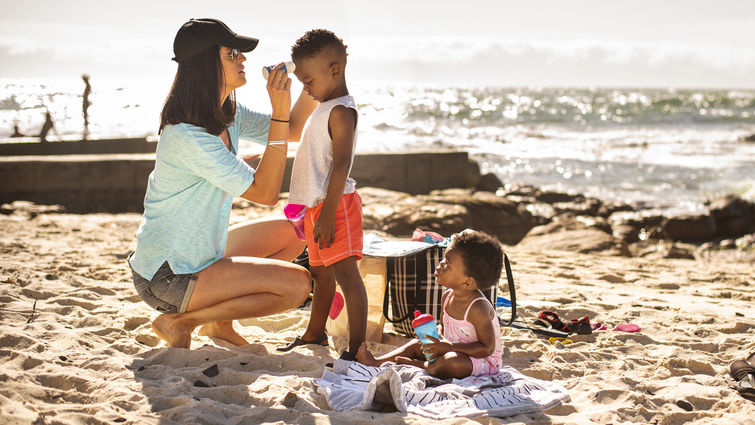
With many products on the market that ensure sun protection, understanding common misconceptions surrounding sunscreens and ultraviolet tall tales is essential. Harry Dao, MD, dermatologist, provides myths he often hears from patients and provides truthful counterpoints.
Myth #1: Being in the car or indoors protects me from UV exposure.
False. There are two types of UV rays, type A and B. While window glass blocks UVB well, UVA can get through. Car windshields block UVA, but side, passenger, and sunroof windows are often not similarly treated. Buses, planes, trains, and even indoors next to a window have similar exposure.
“If you are sensitive to the sun or want extra protection, cars can be treated with special films to block UV radiation and do not necessarily have to be darkly tinted,” Dao says.
Myth #2: If you use sunless tanners, you do not need to use sunscreen because your skin is already tan.
“False! Self-tanners are not a substitute for smart sun protection habits,” Dao says.
Studies show that dihydroxyacetone is a common ingredient in self-tanners but offers minimal SPF protection levels, at most 4, with limited UVA protection. This SPF protection only lasts for several hours after application and does not last for the duration of the tan.
Myth #3: You do not need sunscreen on a cloudy day.
False. Cloudy days are due to a decrease in visible light that can pass through clouds. In fact, over 90% of UV radiation can still pass through clouds and cause DNA damage. Dao says UV protection is still important to remember, even on a cloudy day.
Myth #4: If you have darker skin, you do not have to worry about skin cancer.
“This is false and a very dangerous myth,” Dao says. “People with darker skin can and do get skin cancer. Lack of public awareness results in less UV protection habits and decreased skin cancer screening initiatives, translating into skin cancers found at later stages.”
Sources state that melanomas in patients with darker skin tend to occur on non-UV exposed skin. Sixty to 75% of melanomas may develop on the palms, soles, mucous membranes, and nail sites, complicating efforts at detection.
Myth #5: Reapplying water-resistant sunscreens all day is unnecessary.
False. According to Dao, water-resistant sunscreens come with two main ratings, 40 and 80 minutes. Water-resistant 40-minute sunscreens withstand two 20-minute water immersions, while 80-minute sunscreens withstand four 20-minute immersions. Dao suggests reapplying every 40 or 80 minutes based on your sunscreen’s water resistance rating when engaging in water sports. His general rule of thumb is to reapply sunscreen every two hours.
“Terms like waterproof, all-day protection, or sweatproof are not allowed by the FDA,” Dao says. “This alone suggests the need for reapplication.”
Myth #6: Sunscreen usage should be avoided altogether due to the potential for vitamin D deficiency.
False. A well-balanced diet and supplements contain optimal vitamin D levels.
“The tanning salon industry has tried to perpetuate the notion that UV exposure and tanning are optimal ways to ensure healthy levels of vitamin D,” Dao says. “While achieving optimal vitamin D levels has been reported to help many conditions, this weighs against the known risks of cumulative UV exposure over a lifetime.”
He says not to forget about a healthy diet and nutritional supplementation as advised by your physician.
Myth #7: You do not need additional sun protection under a T-shirt as your skin is covered.
A white shirt conveys only an ultraviolet protection factor (UPF) of 7. UPF is used to designate how protective fabric is against UV. The Skin Cancer Foundation says UPF 30 to 49 offers “very good protection” while UPF 50+ offers “excellent” protection. Dao says UV protection from clothes varies with construction, fit, and color.
Myth #8: SPF 40 sunscreen blocks twice as much radiation as SPF 20 sunscreen.
Dao says a sunscreen with SPF 40 extends the time needed by 40-fold before a given individual’s skin turns red from sun exposure. SPF 20 extends the time by 20-fold. SPF 20 blocks 95% of redness-producing radiation, and SPF 40 blocks 97.5%.
Studies show that people only apply 25 to 50% of the necessary amount of necessary sunscreen to achieve photoprotection. Adults need one ounce or two tablespoons of sunscreen to cover their skin. Dao’s tips to help ensure adequate sunscreen use include applying twice to avoid skipped areas and using a product with twice the SPF factor desired.
Myth #9: A sunscreen with UVB protection SPF 30 or more is the optimal sunscreen recommended.
False. SPF measures only UVB protection. According to Dao, the sun emits the whole electromagnetic spectrum, and skin damage is mainly due to UV exposure. UVB is 1000x as effective in inducing redness versus UVA. However, UVA makes up 95% of the sun’s UV radiation reaching the earth’s surface. UVA radiation causes tanning of the skin as well as skin aging. Dao says UVA and UVB both contribute to skin cancer over time.
“Please remember, wearing sunscreen is about preventing photodamage, skin aging, and skin cancer development, not just avoiding an uncomfortable sunburn,” Dao says.
Visit our appointment page to get quick access to the care you need, where you can schedule an appointment online or through MyChart. You can also schedule an appointment or request more information by calling 909-558-2890.
